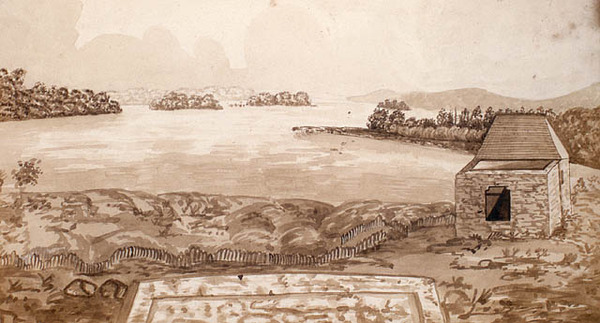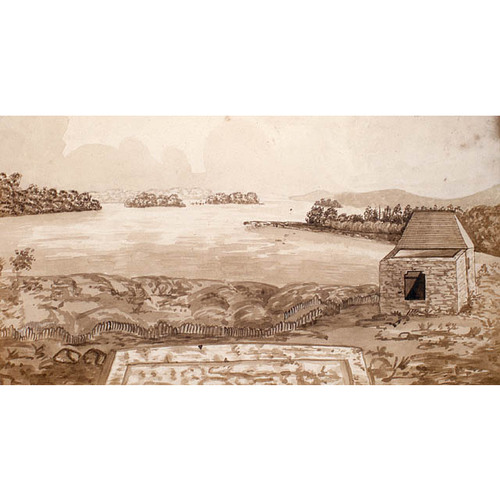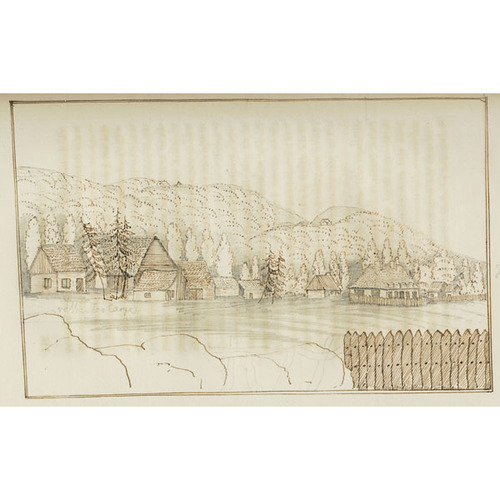BIGSBY, JOHN JEREMIAH, doctor and geologist; b. 4 Aug. 1792 at Nottingham, England, son of Jacob Bigsby; m. probably in 1827 Sarah Beevor of Newark-upon-Trent, England, and they had two children; d. 10 Feb. 1881 in London, England.
John Jeremiah Bigsby, like his father, pursued a medical career, graduating from the University of Edinburgh in 1814 with an md degree. In that same year he published his thesis and joined the Edinburgh Infirmary as a resident physician. On 14 March 1816 he joined the British army as an assistant surgeon, serving briefly in 1817 with the medical corps at the Cape of Good Hope.
In August 1818 Bigsby arrived in British North America as an assistant staff surgeon. Stationed at Quebec City, he was assigned to treat a typhus epidemic among Irish immigrants at Hawkesbury on the Ottawa River in September. On the steamship journey to Hawkesbury, Bigsby’s developing interest in the geology of the St Lawrence region manifested itself in his remarks to Louis-Joseph Papineau*, a fellow passenger. After spending the winter in Quebec Bigsby received instructions in the spring of 1819 from the medical department to study the geology of Upper Canada. During that summer, travelling on the meagre retainer of £26, he collected geological specimens over a wide area encompassed by the Ottawa River and lakes Nipissing, Huron, Erie, and Ontario. That autumn he travelled with the head of the medical department from Quebec to Baie-Saint-Paul, Kamouraska, and La Malbaie, and closely observed the flora and fauna.
During the winter of 1819–20, Bigsby was appointed assistant secretary and medical officer to the British party of the international boundary commission, originally provided for under the terms of the Treaty of Ghent (1814). His appointment appears to have resulted from the fortuitous combination of the resignation of the British secretary and the favourable impression Bigsby may have made on the American party’s chief agent, Major Joseph Delafield, during a chance meeting on the summer tour of 1819. Thus in the spring of 1820 Bigsby set out with the British party, which included David Thompson* as principal surveyor. In August they linked up with Delafield’s party at St Joseph Island in northern Lake Huron and, after leaving the Americans, surveyed Manitoulin, Drummond, and other islands before severe weather forced them to return to Montreal in November.
In the spring of 1821 the commission assembled in the Niagara region, and Bigsby met formally with its board for the first time in May. That summer he took charge of the British party for the determination of the boundary in the Lake St Clair and Lake Erie area. In August, having completed the survey, Bigsby undertook a second tour of the north shore of the St Lawrence at La Malbaie before returning to Quebec for the winter. The commission was idle during the summer of 1822 and Bigsby took the opportunity to visit the Niagara Falls region with an international touring party. However, the next summer saw the survey resume its work with its most ambitious venture, the mapping of the vast region between Fort William (now part of Thunder Bay) and the Lake of the Woods. Bigsby’s association with the commission had not only afforded him a vast area from which to collect geological specimens but also made possible personal associations within the British and American scientific communities.
Bigsby’s reports of his field activities, mostly written during the winters, received public attention in several ways. From 1820 to 1825 he submitted several reports of his field experiences on the St Lawrence and the Great Lakes to Benjamin Silliman’s prestigious American Journal of Science, and Arts. He prepared an account of his activities in the Lake Huron region for Governor Dalhousie [Ramsay*] which was read to the Geological Society of London in 1823 (and published in its Transactions the next year). Bigsby also contributed to the Canadian Review and Literary and Historical Journal, published briefly in Montreal. In 1824 the journal published anonymously “On the utility and design of the science of geology,” which can be attributed to Bigsby because of its style and content; this essay, using evidence gathered in the Canadian field, is one of the first scholarly treatises on geology written in British North America. It shows knowledge of contemporary debates about the geological origins of the earth among the schools of Georges Cuvier, James Hutton, and William Buckland, but the author does not participate in them directly, and instead urges the “practical geologist” to ascertain, by extensive field work and exploration, the nature and composition of the elements of the earth’s crust. The geologist should chronicle facts and collect specimens and secondarily observe in them “the goodness and wisdom of the great Architect; – and his power in the convulsions and consequent devastation which the elements have at intervals caused.” During his years in Canada Bigsby was elected fellow of the Geological Society of London in 1823, an honorary member of the American Geological Society in 1824, and a member of the American Philosophical Society of Philadelphia in 1825.
In late 1826 or early 1827, either for personal reasons or because of the limited official interest shown in the exploitation of Canada’s mineral potential, Bigsby departed for England. He settled in his native Nottinghamshire and established a medical practice in Newark-upon-Trent. There he served as alderman and mayor between 1827 and 1830 and became senior physician at the Newark Hospital in 1840. As part of his continuing interest in lecturing and publishing, from 1827 to 1829 he read several papers before the Geological Society of London on the geology of Canada which were published in the Philosophical Magazine.
With a modest income derived from his practice and his marriage, Bigsby was able to move to London in 1846 and devote more time to his literary and scientific avocations. In 1850 he published a two-volume memoir of his experiences with the boundary commission, The shoe and canoe. A highly readable travel account, it delightfully recaptures incident and accident in the survey, giving close attention to local colour and circumstance, and including his sketches of the landscape. From 1850 to 1864 he read and published numerous papers on North American geology. While in London, Bigsby also prepared an extensive glossary of fossils, the first part of which appeared in 1868 under the title Thesaurus Siluricus. In the book he repeatedly refers to the discoveries of Sir William Edmond Logan*, the first director of the Geological Survey of Canada, and acknowledges his debt to the work of Canadians Elkanah Billings* and John William Dawson*. The following year Bigsby was elected to the Royal Society and received its Murchison Medal. In 1877 he donated the Bigsby Medal to the Geological Society of London to be awarded biennally to a student of American geology under the age of 45. His second dictionary of fossils, Thesaurus Devonico-Carboniferous, was published in 1878 when he was in his mid 80s; a third volume, “Permian Thesaurus,” was nearing completion at the time of his death. Bigsby’s will bequeathed his library and geological works to the borough of Nottingham for the use of the students at the fledgling University College in Nottingham.
John Jeremiah Bigsby’s contributions to Canadian mineralogy and palaeontology were substantial, despite his brief sojourn in British North America. Logan, also a geologist who emphasized “facts then theories,” respected both his facts and his theories; he stated in 1857 that Bigsby’s 1823 essay on the geography and geology of Lake Huron was “the first essay of any importance upon the fossils of Canada.” The Geological Survey of Canada report of 1863 also acknowledges Bigsby’s vital role in the location of certain mineral deposits in the Lake Superior region. George Mercer Dawson*, another director of the Geological Survey and a recipient of the Bigsby Medal in 1891, honoured him in 1878 by giving his name to Bigsby Inlet in the Queen Charlotte Islands.
J. J. Bigsby was the author of the following works: Localities of Canadian minerals, with notes and extracts, chiefly collected from the writings of John Bigsby . . . (Quebec, 1827); “Notes on the geography and geology of Lake Huron,” Geological Soc., Trans. (London), 2nd ser., 1 (1824): 175–209; “On the utility and design of the science of geology, and the best method of acquiring a knowledge of it; with geological sketches of Canada,” Canadian Rev. and Literary and Hist. Journal (Montreal), 1 (1824–25): 377–95; The shoe and canoe, or pictures of travel in the Canadas, illustrative of their scenery and of colonial life; with facts and opinions on emigration, state policy, and other points of public interest . . . (2v., London, 1850); Thesaurus Devonico-Carboniferous: the flora and fauna of the Devonian and carboniferous periods . . . (London, 1878); and Thesaurus Siluricus: the, flora and fauna of the Silurian period . . . (London, 1868). For other publications by J. J. Bigsby see Geologic literature on North America, 1785–1918, comp. J. M. Nickles (2v., Washington, 1923–24), I: 100–1.
PAC, MG 18, H25, 2: no.54; RG 8, I (C ser.), v.0. [Joseph Delafield], The unfortified boundary: a diary of the first survey of the Canadian boundary line from St. Regis to the Lake of the Woods, ed. Robert McElroy and Thomas Riggs (New York, 1943). Robert Etheridge, “Memoir: John Jeremiah Bigsby,” Geological Soc. of London, Quarterly Journal, 37 (1881), [pt.ii]: 39–41. Quebec Gazette, 29 May, 23 Oct., 26 Nov. 1820; 26 Nov. 1821. Times (London), 15 Feb., 13 April 1881. DNB. Zaslow, Reading the rocks.
Cite This Article
Anthony W. Rasporich, “BIGSBY, JOHN JEREMIAH,” in Dictionary of Canadian Biography, vol. 11, University of Toronto/Université Laval, 2003–, accessed December 21, 2025, https://www.biographi.ca/en/bio/bigsby_john_jeremiah_11E.html.
The citation above shows the format for footnotes and endnotes according to the Chicago manual of style (16th edition). Information to be used in other citation formats:
| Permalink: | https://www.biographi.ca/en/bio/bigsby_john_jeremiah_11E.html |
| Author of Article: | Anthony W. Rasporich |
| Title of Article: | BIGSBY, JOHN JEREMIAH |
| Publication Name: | Dictionary of Canadian Biography, vol. 11 |
| Publisher: | University of Toronto/Université Laval |
| Year of publication: | 1982 |
| Year of revision: | 1982 |
| Access Date: | December 21, 2025 |






